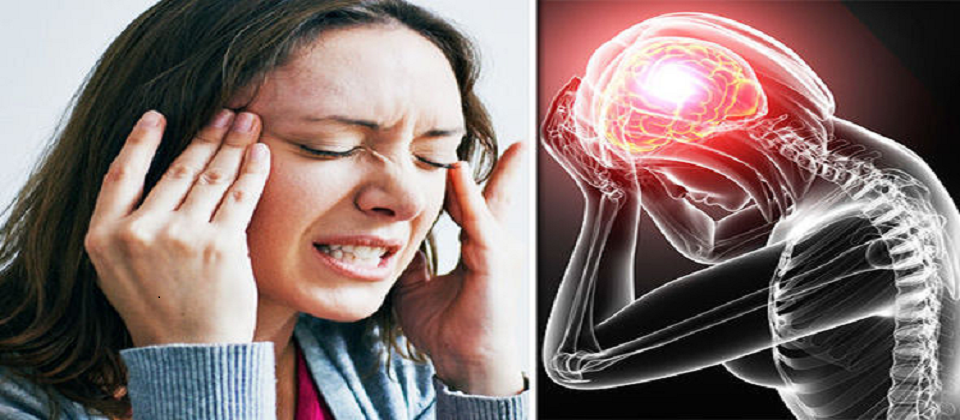
A migraine can cause severe throbbing pain or a pulsing sensation, usually on just one side of the head. It’s often accompanied by nausea, vomiting, and extreme sensitivity to light and sound.
Symptoms
Migraines often begin in childhood, adolescence or early adulthood. Migraines may progress through four stages: prodrome, aura, headache and post-drome, though you may not experience all stages.
Prodrome
One or two days before a migraine, you may notice subtle changes that warn of an upcoming migraine, including:
Constipation
Mood changes, from depression to euphoria
Food cravings
Neck stiffness
Increased thirst and urination
Frequent yawning
Aura
Aura may occur before or during migraines. Most people experience migraines without aura.
Auras are symptoms of the nervous system. They are usually visual disturbances, such as flashes of light or wavy, zigzag vision.
Sometimes auras can also be touching sensations (sensory), movement (motor) or speech (verbal) disturbances. Your muscles may get weak, or you may feel as though someone is touching you.
Each of these symptoms usually begins gradually, builds up over several minutes and lasts for 20 to 60 minutes. Examples of migraine aura include:
Visual phenomena, such as seeing various shapes, bright spots or flashes of light
Vision loss
Pins and needles sensations in an arm or leg
Weakness or numbness in the face or one side of the body
Difficulty speaking
Hearing noises or music
Uncontrollable jerking or other movements
Sometimes, a migraine with aura may be associated with limb weakness (a hemiplegic migraine).
Attack
A migraine usually lasts from four to 72 hours if untreated. The frequency with which headaches occur varies from person to person. Migraines may be rare or strike several times a month. During a migraine, you may experience:
Pain on one side or both sides of your head
Pain that feels throbbing or pulsing
Sensitivity to light, sounds, and sometimes smells and touch
Nausea and vomiting
Blurred vision
Lightheadedness, sometimes followed by fainting
Post-drome
The final phase, known as post-drome, occurs after a migraine attack. You may feel drained and washed out, while some people feel elated. For about 24 hours, you may also experience:
Confusion
Moodiness
Dizziness
Weakness
Sensitivity to light and sound
Natural Ways to Reduce a Migraine
Avoid hot dogs
Diet plays a vital role in preventing migraines. Many foods and beverages are known migraine triggers, such as:
foods with nitrates including hot dogs, deli meats, bacon, and sausage, chocolate.
cheese that contains the naturally-occurring compound tyramine, such as blue, feta, cheddar, Parmesan, and Swiss
alcohol, especially red wine
foods that contain monosodium glutamate (MSG), a flavour enhancer
foods that are very cold such as ice cream or iced drinks
processed foods
pickled foods
beans
dried fruits
cultured dairy products such as buttermilk, sour cream, and yoghurt
A small amount of caffeine may ease migraine pain in some people. Caffeine is also in some migraine medications. But, too much caffeine may cause a migraine. It may also lead to a severe caffeine withdrawal headache.
Apply lavender oil
Inhaling lavender essential oil may ease migraine pain. According to 2012 research, people who inhaled lavender oil during a migraine attack for 15 minutes experienced faster relief than those who inhaled a placebo. Lavender oil may be inhaled directly or applied diluted to the temples.
Try acupressure
Acupressure is the practice of applying pressure with the fingers and hands to specific points on the body to relieve pain and other symptoms. According to a 2014 systematic review, acupressure is a credible alternative therapy for people in pain from chronic headaches and other conditions. A separate study found acupressure may help relieve migraine-associated nausea.
Look for feverfew
Feverfew is a flowering herb that looks like a daisy. It’s a folk remedy for migraines. According to a 2004 systematic review, however, there’s not enough evidence that feverfew prevents migraines. Still, many people claim it helps their migraine symptoms without side effects.
Apply peppermint oil
The menthol in peppermint oil may stop a migraine from coming on, according to a 2010 study. The study found that applying a menthol solution to the forehead and temples was more effective than placebo for migraine-associated pain, nausea, and light sensitivity.
Go for ginger
Ginger is known to ease nausea caused by many conditions, including migraines. It may also have other migraine benefits. According to research, ginger powder decreased migraine severity and duration as well as the prescription drug sumatriptan, and with fewer side effects.
Sign up for yoga
Yoga uses breathing, meditation, and body postures to promote health and well-being. Research shows yoga may relieve the frequency, duration, and intensity of migraines. It’s thought to improve anxiety, release tension in migraine-trigger areas, and improve vascular health.
Although researchers conclude it’s too soon to recommend yoga as a primary treatment for migraines, they believe yoga supports overall health and may be beneficial as a complementary therapy.
Add magnesium to your diet
Magnesium deficiency is linked to headaches and migraines. Studies show magnesium oxide supplementation helps prevent migraines with aura. It may also prevent menstrual-related migraines
You can get magnesium from foods that include:
almonds
sesame seeds
sunflower seeds
Brazil nuts
cashews
peanut butter
oatmeal
eggs
milk
Book a massage
A weekly massage may reduce migraine frequency and improve sleep quality, according to a 2006 study. The research suggests massage improves perceived stress and coping skills. It also helps decrease heart rate, anxiety, and cortisol levels.
Also Read: These are the signs and symptoms of Diabetes

Post Your Comments